Email Marketing 101: A Comprehensive Guide
Email marketing, according to the Content Marketing Institute, is one of the top free organic traffic platforms for eCommerce marketers. Furthermore, in the B2C industry, 80 percent of business professionals agree that email marketing improves customer retention.
As internet use grows across the world, email marketing has become an essential tool for many brands and marketers to stay connected with their customers. Approximately 300 billion emails were sent and received every day around the world in 2019, and this number is projected to increase to 376 billion in 2025.
With the increasing popularity of email, it’s no surprise that email marketing has become a valuable marketing tool for businesses all over the world. However, getting started as an email marketing beginner can be daunting. If you’re not sure about getting started and looking for some email marketing 101, you have come to the right place! In this article, I will share with you everything you need to know about email marketing and how you can run successful campaigns. Let’s jump right into the details!
What is Email Marketing?
Email marketing is a digital marketing practice that allows you to reach, connect with, and build good relationships with prospects and customers. As the name says, this is a marketing approach that is based on sending out emails to a selected audience. Emails are fundamentally used to achieve commitment and a long-term relationship with customers.
However, as you will see, successful email marketing requires more than just sending emails. When your email marketing campaigns are successful, you can transform prospects into customers quickly. You may also have an effect on purchasing decisions and recurring transactions. The first email was sent in 1971, and there are now 3.9 billion email users worldwide.
The Benefits of Email Marketing
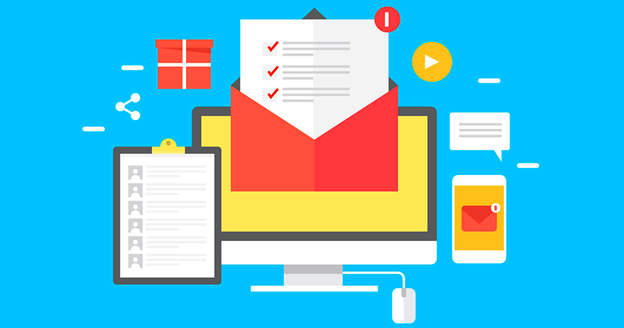
Email marketing is not dead, although many people say it is. It is still nearly as effective, if not more so, than other marketing channels. The following are some of the reasons why both small and large companies should seriously take their email marketing campaigns.
Extensive Reach
In 2018, there were 3.8 billion email users worldwide, according to Statista. By 2023, this number is projected to increase to 4.4 billion. In comparison, there were roughly 2.65 billion social media users worldwide in 2018, with this number projected to grow to 3.1 billion by 2021. Furthermore, email marketing helps you to reach out to your subscribers whether they are on mobile or desktop. As per email marketing statistics, while PC accounts for 45.69 percent of email open, mobile devices account for 34.31 percent of email opens.
Higher Engagement Rates
Engagement rates on social media (Facebook, Instagram, and Twitter) were about 0.58 percent. Meanwhile:
-
Your emails would hit approximately 85 percent of your intended recipients. This instantly increases the probability that your readers will see your content instead of social media, where you do not influence whether or not your followers view your posts.
-
Across sectors, emails have an open rate of 22.86 percent.
-
Emails have a click-through rate of 3.71 percent, which is more than six times that of the social media sites listed above.
Low Cost, High ROI
Email marketing service providers offer plans and affordable rates that differ depending on functionality and subscriber count. If you are just getting started and want to create your contact list, look for a provider that has a simple plan that already includes features like email marketing automation and subscriber list segmentation.
Email marketing has a relatively high return on investment as compared to its expense (ROI). According to a 2018 Litmus survey, the ROI is an average of $38 per $1 expended, with other reports estimating possible returns of up to $44 per $1 allocated for email marketing activities.
Easier Tracking
According to a HubSpot report from 2018, the top marketing challenges for marketers in 2018 were proving the ROI of marketing activities (39 percent) and securing an adequate budget (27 percent). According to another Hubspot report, “marketers who calculate ROI are 1.6 times more likely to receive higher budgets.”
Email marketing addresses the problem of marketers because email software providers allow you to monitor the results of your campaigns. You’ll have data to show higher-ups how much money your email campaigns have earned if you monitor your performance. Simultaneously, you can more quickly find ways to increase the deliverability and engagement of your emails.
Greater Customization
Unlike other marketing platforms, there are various choices for customizing and automating email campaigns. You can design your own email templates and A/B tests different variables. You can also segment your subscribers based on common features, potential/current clients, materials they’ve downloaded, courses they’ve enrolled in, and so on.
This enables you to create consumer journeys and automation workflows customized to that particular segment. Instead of offering the same product to all of your audience, you can create unique deals for existing customers and only provide free shipping to those who have yet to make a purchase.
Types of email marketing
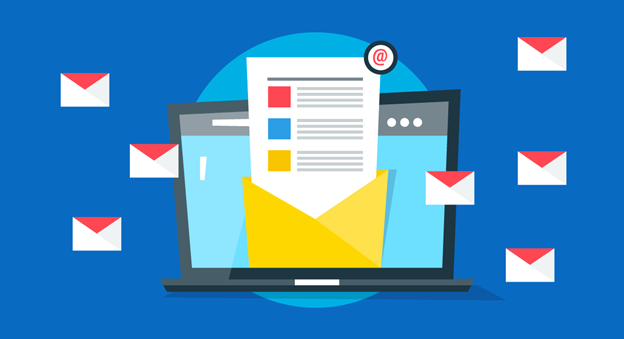
There are many different types of emails that you can use in your marketing campaign. You can use them individually or collectively based on your email marketing strategy.
Welcome Email
You have one opportunity to make a good first impression. And if you don’t make a successful first impression on a potential subscriber, your follow-up campaigns won’t be either.
The welcome email is an important campaign in your arsenal, driving three times the transaction and revenue per email of any other promotional mailing. Its aim is to thank subscribers for joining your list, create expectations for what’s to come (for example, how often you’ll email them), and, when done correctly, simplify your sales process. Pandora, for example, rewards new subscribers by including a discount code:
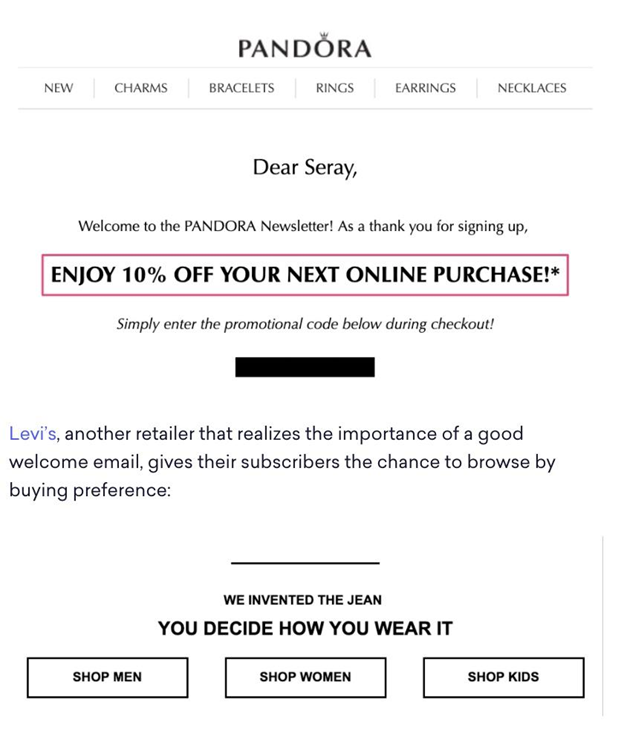
Here are a few things to think about:
- Strive for originality. If you want to stand out in your audience’s inbox, you must be special.
And that entails doing something unexpected for your subscribers. Offer a discount. Talk in their native tongue. Inform them that you expect an answer to your email. Give them everything they need to know that they’ve come to the right location.
- Design for simplicity. Remove obstacles to buying if you have a large product line. Make it easy for new subscribers to search what you have to offer, whether it’s by product category or something else.
Read more: 11 Welcome Email Templates That Always Win Your Customers
Engagement Email
Copywriter Gary Halbert was popular in the golden age of direct response marketing for adding “grabbers” like dollar bills to mailings. Why did he do so? He needed to get the attention of his prospects. With the average office worker receiving 122 emails every day, it’s critical that you encourage subscribers to connect with your emails if you want to remain visible in their inbox.
Although adding cryptocurrency to campaigns might not be a viable choice, there are other ways to increase interaction (and without breaking the bank). Brooklinen, for example, attracts engagement by providing free shipping:
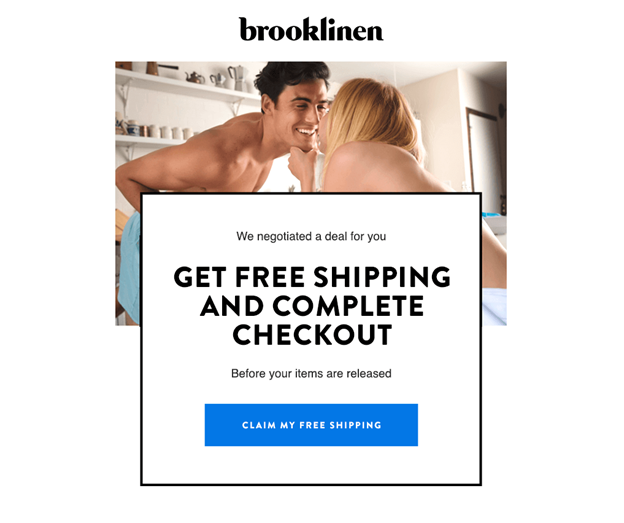
Brooklinen understands that shipping is a frequent cause of cart abandonment. So, not only do they provide free shipping to customers, but they also provide a way for them to get it. Brooklinen understands that people deserve something that they have to fight for and free shipping is no exception.
Campaigns like the one described above attract engagement and foster a two-way partnership between Brooklinen and their customers. So, if you’re providing free shipping or encouraging customers to begin a free trial, give readers a reason to connect with your promotions, and remember to make it memorable.
The Referral Email
It’s no secret that asking consumers to refer their friends and family to a brand is a perfect way to create free leads. According to a new BigCommerce study, 74 percent of customers consider word-of-mouth to be a major influencer in their buying decision.
And with that statistics, it’s easy to see why marketers spend time creating attractive referral services. You could already be asking for referrals on your thank you page (if not, you should be). But you can do that in your email campaigns as well.
Bombas is an excellent example of asking for referrals. They not only have straightforward instructions in their email, but they also provide a free pair of socks as a bonus:
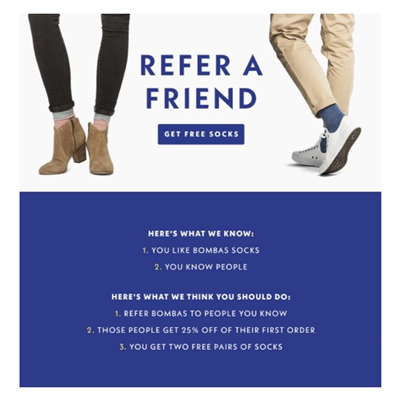
You may not be able to offer free products to each referral (only a few can), but you certainly have enough in your marketing budget to offer a thank you note (or at least an Internet high five).
Discount Email
Discounting is a strong eCommerce marketing tool. According to one VWO survey, 72 percent of Millennial shoppers are open to retargeting via discounts.
54 percent of shoppers are likely to repurchase abandoned items if they are sold at a lower price. (More on that later.) Blue Apron, an American meal delivery service, often offers discounts to customers in order to entice further sales (note the scarcity to evoke the fear of losing out):
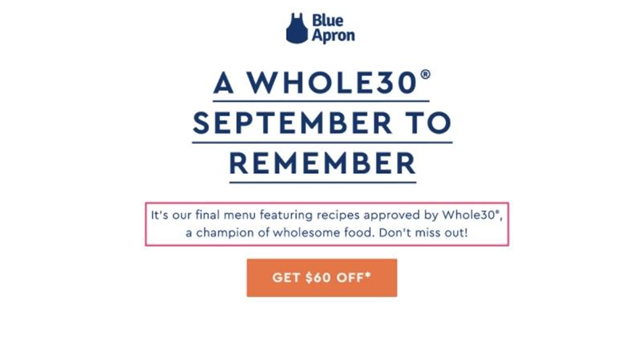
But be careful: while discounting is powerful, you must strike a balance. If you do it too often, your sales will suffer; if you do it too infrequently, you risk losing customers to a rival. The silver lining, then, is to only give discounts to subscribers who participate in your campaigns (e.g., opening emails, clicking links, etc.).
Cart Abandonment Email
It’s something we’ve always done. We’re online, going through the checkout process on a website when something catches our eye. A knock on the door, a Facebook message, our phone rings, and we didn’t even bat an eyelid when we abandoned our cart.
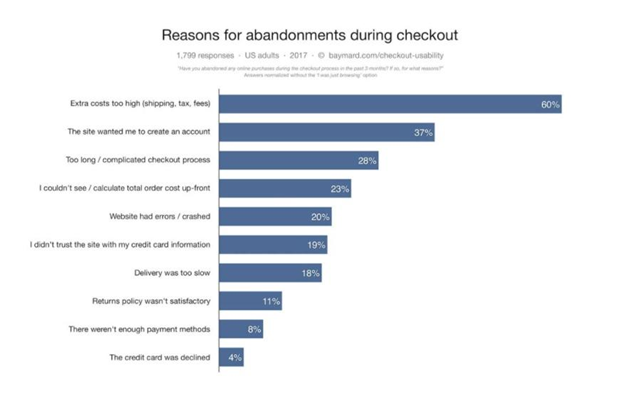
According to a recent survey, 69 percent of all eCommerce shoppers abandon their shopping cart, with 61 percent citing shipping costs as the primary reason: Beardbrand, a men’s grooming brand, turns cart abandoners into consumers by answering and solving the following objection—shipping costs—in a cart recovery email:
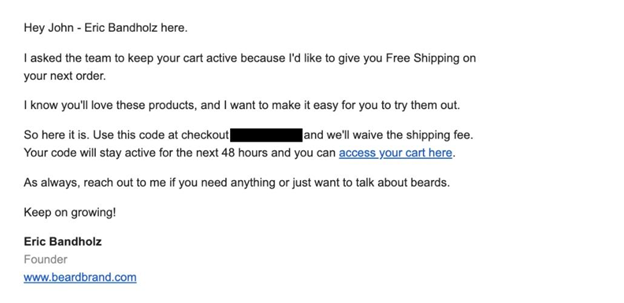
When you know a customer’s lifetime value, as Beardbrand most definitely does, you can afford to provide discounts to encourage cart completion. “But what if your margin is too thin to compete on shipping?” you might be wondering. The solution is simple: ask for feedback.
That is precisely what Ugmonk does. This email is what a customer a few hours after leaving their cart:
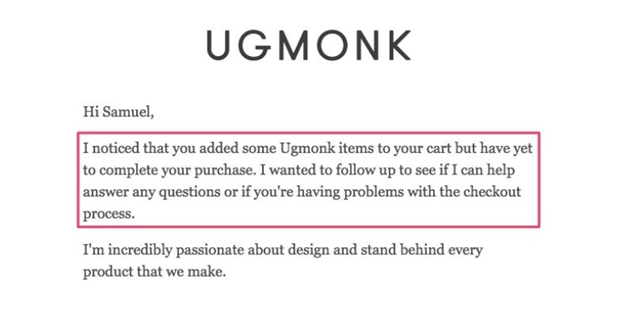
You can’t always convert dissatisfied customers. That is evident. However, you should make an attempt to find out why they did not complete their order. And, using what you’ve learned, you can strengthen the checkout process for potential customers.
Read more: Shopping Cart Abandonment: From A to Z
Order Confirmation Email
A fascinating observation after reviewing 100,000+ email receipts: Per order confirmation email generates $0.25 in additional revenue for e-commerce stores:
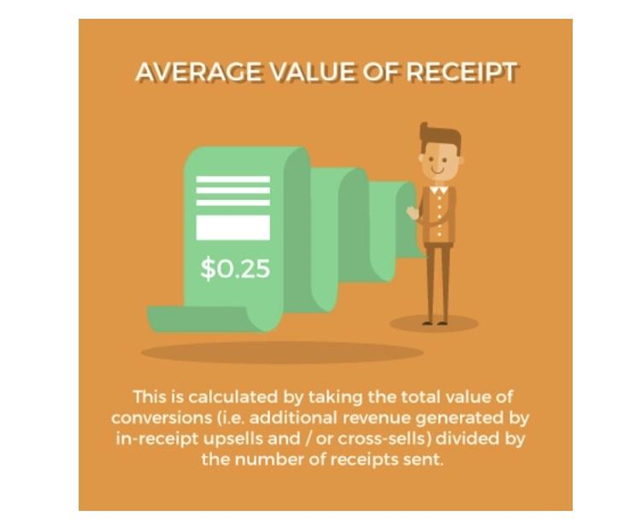
Doesn’t sound like much, does it? I didn’t believe it either. But then I did the math: for every 100 receipts you give, you will make an extra $0.25 in revenue with no additional effort.
Isn’t that a great deal for automated email marketing? Although the order confirmation email is another way to improve sales, it also acts as a way to set consumer expectations. Joybird, an online furniture retailer, includes an explainer video in their order confirmation email to walk customers through the delivery process:
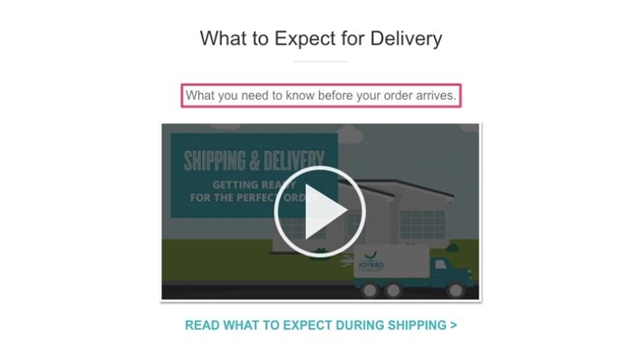
Remember that your order confirmation email serves as more than just a digital receipt; it also serves as a reminder to customers that purchasing from you was the right decision.
Read more: How To Write Order Confirmation Emails?
Upsell, Crosssell Email
You’ve already heard of upselling and its cousin, cross-selling. If you aren’t, here’s a quick refresher:
-
If you invite a prospect to purchase a more expensive item to raise their average order value, you are upselling.
-
Cross-selling is the practice of recommending a similar commodity or complementary to the one being sold.
It is for this reason that McDonald’s asks, “Do you want fries with that?” and why Amazon suggests items that are often purchased together:
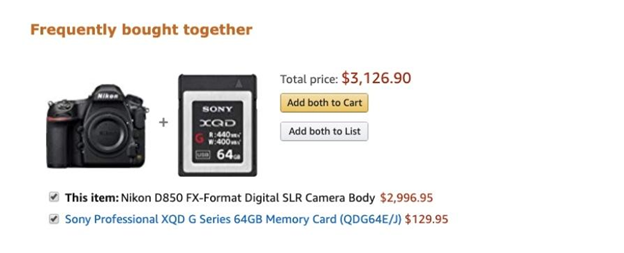
With repeat customer spending, on average, 67 percent more in months 31th-36th than in the first 6 months, it’s no wonder that many eCommerce brands routinely upsell items to consumers who have already purchased. Beardbrand recommends the following products to new customers after they place an order:
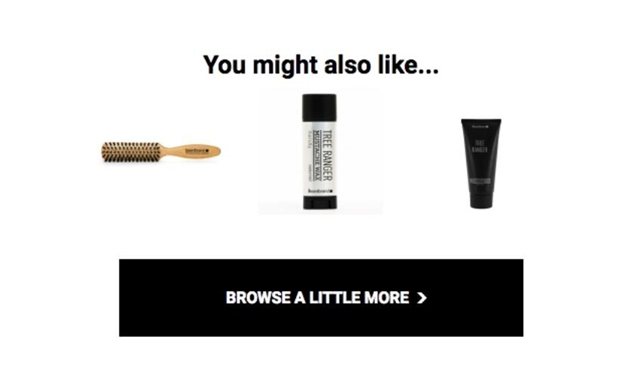
If cross-selling isn’t an option for you, consider tiered pricing. Apuls, an online store specializing in fitness equipment, entices consumers to spend more money by showing a value ladder in one of their popups. From left to right, the price of the item they sell, an exercise bike, rises, offering customers more options.
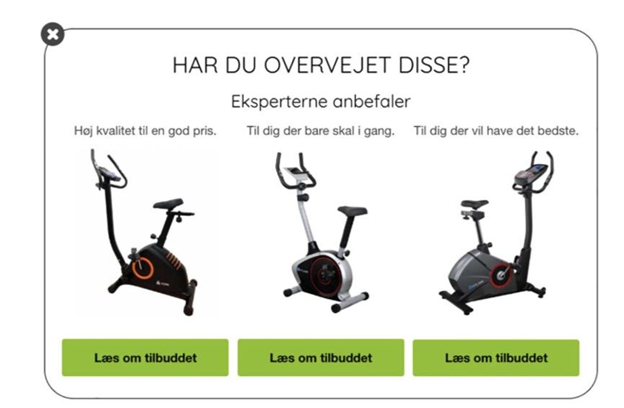
Read more: How To Write Cross-sell Emails?
Win-back Email
It’s happened to me, and it’s very possible that it’s happened to you as well. You devote time, effort, and resources to expanding your list just to have a portion of your subscribers unsubscribe, or worse, disengage entirely (costing you money in the process).
Every year, email marketing databases degrade by around 22.5 percent. With this in mind, it is vital that you re-engage members who have been inactive (especially if you want to lower your email unsubscribe rates). Here’s an example of a win-back email from Fotolia:
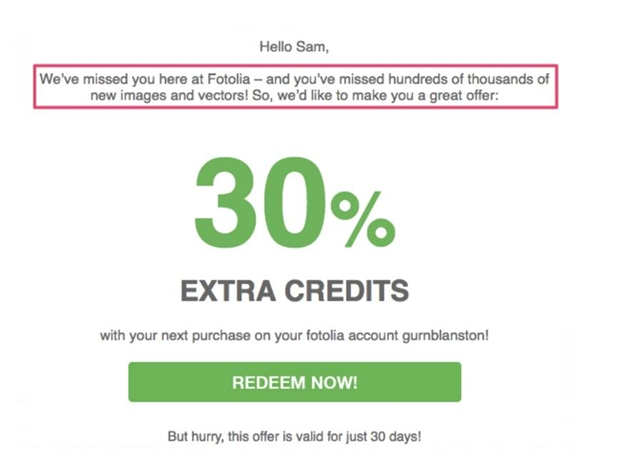
Read more: How To Write Win Back Emails?
Survey Email
Similarly, if you don’t ask your subscribers what they want on a regular basis, how do you hope to send them what they want? Surveying your customers provides you with more than just useful insights into their goals, preferences, and pain points; it also helps you to enhance your email marketing. Many brands, such as Frye, offer participants the opportunity to win a gift certificate if they participate:

Thank You Email
We don’t always say thank you enough. And if we do, it is rare that we really mean it. Thanking your audience entails more than simply thanking them for subscribing to your newsletter or making a purchase; it entails realizing that they are the reason you are in business.
That is why, every now and then, companies like Brooklinen would write from the heart to thank their customers for making what they do possible:
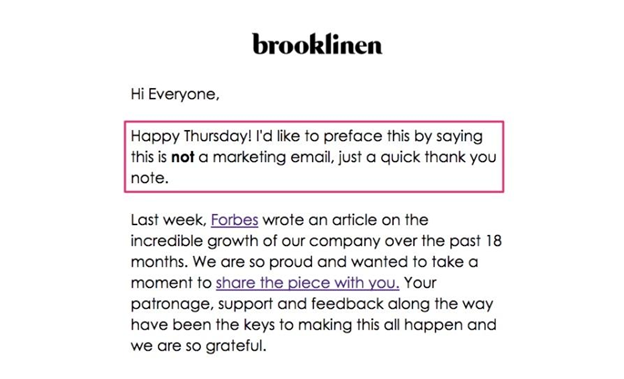
It’s quick to drown in the minutiae of daily business life. However, thanking your customers will go a long way. How do you give back to the people who have helped you and your business become what they are today?
Read more: Best eCommerce Thank You Email Templates
Email Marketing Metrics and KPIs
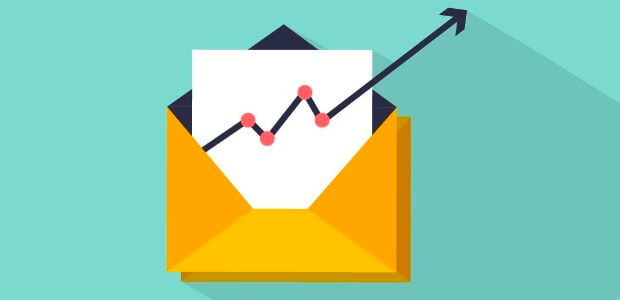
Email marketing KPIs allow you to evaluate the efficacy of your email marketing campaign.
There are ten important metrics and main performance measures (KPIs) to which you should pay attention. They are as follows:
- Number of Emails delivered
- Number of Emails opened
- Click-through rate (CTR)
- Bounce rate (hard and soft)
- Unsubscribe rate
- Social shares
- Spam complaints
- Forwards
- Conversion (this is the most important metric).
Email Marketing Best Practices
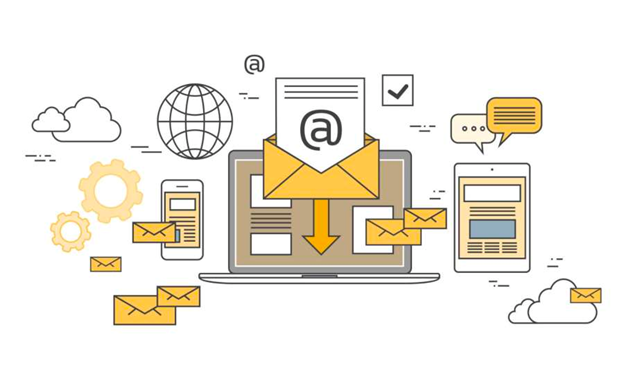
These are timeless email marketing practices, and they are proven to be effective. You can’t afford to overlook them if you want to run successful email marketing campaigns.
Build an email list
Build, and don’t buy an email list. This is very important since you will end up hurting rather than improving your campaign. The explanation for this is that purchased email lists often include people who are uninterested in your goods and, as a result, are unlikely to open your email, lowering your open and click-through rates.
If you have a low open rate for an extended period of time, your email will be considered spam and will be routed to the spam folder. The first step in launching a successful campaign is to build an email list from scratch.
Write a strong subject line
Your subject line needs to be strong and catchy as it will be the first thing the email recipient looks at. It will decide whether or not your email is opened, regardless of how good the content is.
Read more: Best subject lines example
Customize your pre-header
Similar to the subject line, your email subscriber will see the pre-header without opening the email. It will be the second thing your subscribers look at and use to decide whether they need to open the email. Ensure that your offer is shown in the pre-header to entice those interested in it to open your email.
Personalize your email
Not only can you customize the pre-header, but you can also customize each email to be personalized to each recipient. A pre-header suggesting that the email is customized will dramatically boost your CTR. Personalized emails give the recipients the feeling that the content of the email is tailored to them personally.
Read more:
Add your branding elements to your email
Every email is your brand’s way of communicating with your subscribers. As a consequence, your email template should include your logo, a distinct signature, or something else that lets your subscribers know the email is from you.
Use a strong call-to-action
Don’t assume that your recipients will know what to do after reading your email. That’s why you need a call to action; it will tell your audience exactly what to do next. CTAs will help you turn prospects into customers. CTAs should be clearly visible and strategically positioned in the body of your email.
Prove the unsubscribe option
You don’t want someone to unsubscribe from your email. That is right. No business does. However, your recipient is the one who decides whether your email is relevant to them. Your email subscribers can change as your brand evolves. Tastes and desires change over time. It is, therefore, essential to provide your subscribers with the opportunity to unsubscribe if they want to.
It is not only a best practice, but it is also the law. According to the Federal Trade Commission and the CAN-SPAM Act, you must have a “clear and conspicuous explanation of how the recipient can opt-out of receiving emails from you in the future.”
Best email marketing tools
There are several email marketing tools on the market, from freemium to paid plans. I’ll recommend these three tools for ease of use and affordability: AVADA Email & SMS Marketing, Drip, and GetResponse.
AVADA Email and SMS Marketing
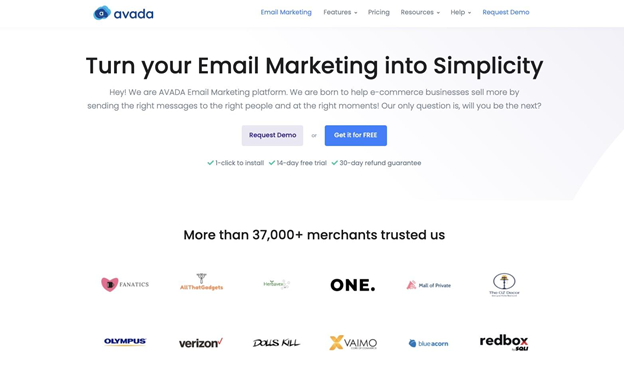
AVADA Marketing Automation is a comprehensive marketing tool. Aside from offering a free forever package, AVADA Email & SMS Marketing is also simple to use, making it a perfect option for new businesses and start-ups.
Features include email automation, list segmentation, drag-and-drop email builder, and advanced reports. You can also use the premade templates to create email campaigns if you don’t have time to design your own. Paid plans start at $9 for 1,000 subscribers and go up as your number of subscribers increases. You can enjoy unlimited emails with any paid plan you choose.

Drip
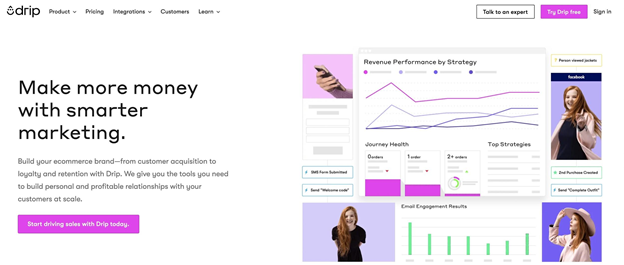
Drip is an excellent option for eCommerce company owners or anyone selling a variety of goods and services.It is easy to use even for inexperienced users. Furthermore, it enables users to build advanced marketing sequences as well as deeper segmentation and personalizations.
Drip provides a two-week free trial during which you can test all of its features. Paid plans start at $19/month for 500 subscribers and go up as your number of subscribers increases.
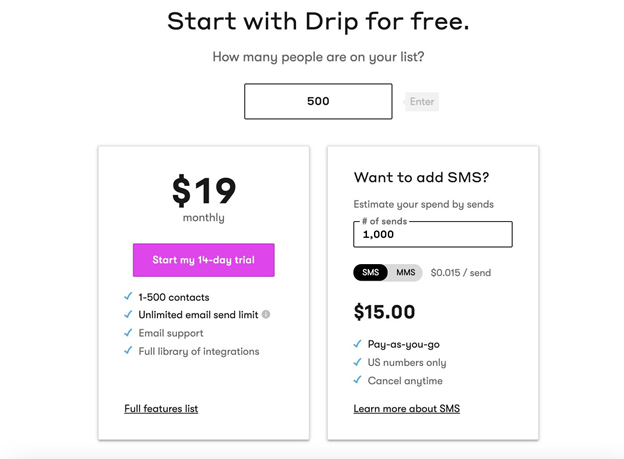
GetResponse
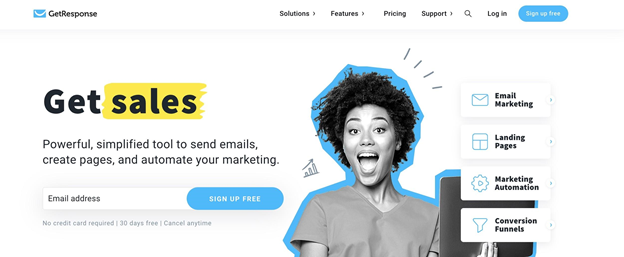
GetResponse can help small and medium-sized companies quickly build landing pages, emails, and build email marketing funnels.
They also offer webinar marketing solutions and the functionality to segment your list and A/B test your emails. GetResponse provides a 30-day free trial for their plans, which begin at $15/month for a list size of 1,000 subscribers.
If you don’t want to upgrade your plan but want to increase your list’s size, simply click on the dropdown menu next to “List Size” per plan. The Pricing page will automatically calculate the cost of the plan. A Simple Plan with a list size of 5,000, for example, would cost $45 per month.

Final words
That’s it! I hope this email marketing 101 article has provided you with everything you need to create and run your first campaign. Please feel free to leave comments below for a further discussion on this topic!
New Posts






